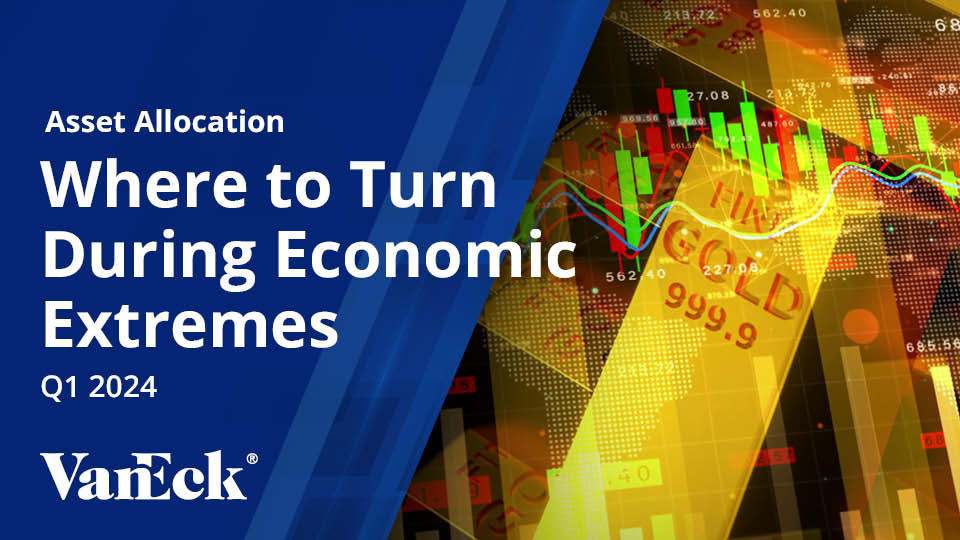Bitcoin Pulls Ahead
March 11, 2021
Read Time 6 MIN
The VanEck Vectors® Real Asset Allocation ETF (RAAX®) uses a data-driven, rules-based process that leverages over 50 indicators (technical, macroeconomic and fundamental, commodity price, and sentiment) to allocate across 12 individual real asset segments in five broad real asset sectors. These objective indicators identify the segments with positive expected returns. Then, using correlation and volatility, an optimization process determines the weight to these segments with the goal of creating a portfolio with maximum diversification while reducing risk. The expanded PDF version of this commentary can be downloaded here.
Overview
The VanEck Vectors® Real Asset Allocation ETF (“RAAX”) returned +4.61% versus +6.47% for the Bloomberg Commodity Index. In general, most real assets continue to benefit from the expectation of higher inflation, while oil prices were lifted higher due to supply constraints that resulted from the deadly storm in Texas. On the other hand, income producing real assets were negatively impacted by the rapid surge in interest rates. Gold prices remain under pressure due to optimism about future growth and the subsequent rise in interest rates. And lastly, Bitcoin, which RAAX added exposure to for the first time last month, surged from $32,601 to an intra-month and all-time high of $57,355.
RAAX benefited from its exposure to Bitcoin. Bitcoin continues to challenge gold as the top store-of-value asset. And, given that price action is the determinant of success in investing, Bitcoin is clearly winning. The digital asset temporarily reached an all-time high of $57,355 and a market capitalization of $1 trillion. Bitcoin is quickly catching up to gold with a market cap of $11 trillion. The digital asset was propelled higher by institutional buy-in, inflation fear and market speculation. Two notable institutions supporting the asset are Tesla and Mastercard. Telsa announced that it invested $1.5 billion in Bitcoin and Mastercard announced that it will allow customers to use some cryptocurrencies.
| Average Annual Total Returns (%) as of February 28, 2021 | ||||
| 1 Mo† | YTD† | 1 Yr | Life | |
| (04/09/18) | ||||
| RAAX (NAV) | 4.61 | 12.15 | 7.10 | 0.61 |
| RAAX (Share Price) | 4.63 | 12.15 | 7.43 | 0.67 |
| Bloomberg Commodity Index* | 6.47 | 9.27 | 20.32 | 0.31 |
| Average Annual Total Returns (%) as of December 31, 20201 | ||||
| 1 Mo† | YTD† | 1 Yr | Life | |
| (04/09/18) | ||||
| RAAX (NAV) | 0.44 | -13.73 | -13.73 | -3.50 |
| RAAX (Share Price) | 0.18 | -13.72 | -13.72 | -3.51 |
| Bloomberg Commodity Index* | 4.97 | -3.12 | -3.12 | -2.86 |
The table presents past performance which is no guarantee of future results and which may be lower or higher than current performance. Returns reflect temporary contractual fee waivers and/or expense reim¬bursements. Had the ETF incurred all expenses and fees, investment re¬turns would have been reduced. Investment returns and ETF share values will fluctuate so that investors’ shares, when redeemed, may be worth more or less than their original cost.
1Source: Bloomberg. Please note that the returns include the distribution on the ex-date of December 29, 2020 but not the potential reinvestment that occurred on January 5, 2021. Had the returns above included reinvested distributions, the returns would have been higher. Please visit our website at https://www.vaneck.com/us/en/resources/tax-and-distributions/etfs/ for additional information.
†Returns less than a year are not annualized.
Expenses: Gross 1.35%; Net 0.78%. Expenses are capped contractually at 0.55% through February 1, 2022. Expenses are based on estimated amounts for the current fiscal year. Cap exclude certain expenses, such as interest, acquired fund fees and expenses, and trading expenses.
RAAX invests in three types of real assets: financial assets, income assets and resource assets. This month’s allocation to financial assets is 25.5%, it allocation to resource assets is 50.3% and its allocation to income assets is 24.2%.
RAAX Asset Allocation Across Financial, Income and Resource Assets (as of March 2, 2021)
Source: VanEck
Performance Review
In February, the largest contributors to performance were resource assets, with a return of +10.18%, and income assets, with a return of +3.71%. The largest detractor from performance was financial assets, with a return of -4.33%.
Total Return and Contribution (February 2021)
Data as of February 28, 2021. Source: FactSet. Past performance does not guarantee future results. Please see index descriptions in Disclosure.
Within resource assets, diversified commodities returned +10.35%. Commodity prices continued to be led higher by energy in February, with Brent crude futures up 20.15% and WTI crude oil futures up 17.82%. The spike in oil prices was largely due to the storm in Texas that shut down the state’s infrastructure and resulted in an estimated 3 million barrels per day of lost oil production. This supply squeeze is happening with the oil industry already in the process of restricting supply. This has been further exacerbated by an expected increase in demand as vaccinations are expected to drive an economic rebound.
Natural resource equities were led higher by traditional energy, which clearly benefited from higher oil prices. RAAX’s exposure to unconventional oil and gas companies returned +27.63%, oil services companies returned +23.43% and diversified energy companies returned +22.46%. Other natural resource equities continued to benefit from inflation concerns. RAAX’s exposure to base metal companies returned +13.03% and agriculture companies returned +7.58%. The largest detractor from the natural resource equity segment of the portfolio was sustainable energy, which returned -7.64%. These companies were particularly vulnerable to the rapid increase in interest rates in February due to their lofty valuations based on aggressive future growth assumptions.
Resource Assets: Total Return and Contribution (February 2021)
Data as of February 28, 2021. Source: FactSet. Past performance does not guarantee future results. Please see index descriptions in Disclosure.
The income assets, in aggregate, are yielding +3.76% based on 12-month yields. The top performing position was MLPs, up 7.17%, which benefited from higher oil prices. REITs and infrastructure were both negatively impacted by the rapid increase in interest rates. The yield on the 10-year U.S. Treasury note increased from 1.08% to an intra-month high of 1.52%. Higher yielding assets are negatively impacted by rising interest rates because, when interest rates rise, the yields on these assets become less attractive relative to U.S. Treasuries.
Income Assets: Total Return and Contribution (February 2021)
Data as of February 28, 2021. Source: FactSet. Past performance does not guarantee future results. Please see index descriptions in Disclosure.
The financial assets were the largest detractor from performance with an aggregate return of -4.33%. Within the financial assets, gold was the largest detractor from performance. RAAX’s exposure to gold bullion returned -6.26% and gold mining equities returned -9.79%. Gold prices remain under pressure as investors continue to flee the safe haven asset in favor of more risky assets. The increased appetite for risk is based on the expectations of higher growth and the safety net of abundant monetary and fiscal stimulus. This optimism is the driving force behind the rapid increase in interest rates.
Financial Assets: Total Return and Contribution (February 2021)
Data as of February 28, 2021. Source: FactSet. Past performance does not guarantee future results. Please see index descriptions in Disclosure.
February was another good month for real assets, which were led higher by both oil and bitcoin. Higher interest rates were a setback for many real assets, particularly sustainable energy, gold and income producing real assets. Real assets, overall, continue to benefit from the recent fears of inflation and hopes of higher global growth in the second half of 2021.
The chart below shows the real asset risk composite that measures extreme risk within real assets using various quantitative signals. The current score is 7, which indicates a stable risk regime for real assets.
Source: VanEck
As part of its monthly rebalance entering March, RAAX added 2.5% in exposure to bitcoin and nearly 2% to resource assets including natural resource equities. It was funded primarily by reductions in gold bullion and diversified commodities.
Monthly Asset Class Change
| Mar-21 | Feb-21 | Change | |
| Financial Assets | 25.5% | 27.0% | -1.5% |
| Bitcoin | 4.7% | 2.1% | 2.6% |
| Gold Equities | 4.2% | 4.9% | -0.7% |
| Gold Bullion | 16.6% | 20.0% | -3.4% |
| Income Assets | 24.2% | 24.6% | -0.4% |
| REITs | 14.1% | 14.5% | -0.4% |
| MLPs | 5.3% | 5.2% | 0.1% |
| Global Infrastructure | 4.8% | 4.9% | -0.1% |
| Resource Assets | 50.3% | 48.4% | 1.9% |
| Low Carbon Energy Equities | 8.2% | 8.1% | 0.1% |
| Diversified Commodities | 20.1% | 20.5% | -0.4% |
| Global Metals & Mining Equities | 2.7% | 2.5% | 0.2% |
| Steel Equities | 2.6% | 2.4% | 0.2% |
| Unconventional Oil & Gas Equities | 3.4% | 2.8% | 0.6% |
| Oil Services Equities | 3.5% | 2.9% | 0.6% |
| Energy Equities | 4.6% | 4.3% | 0.3% |
| Agribusiness Equities | 5.2% | 5.0% | 0.2% |
| Cash | 0.1% | 0.0% | 0.1% |
Related Topics
Related Insights
February 28, 2024
February 22, 2024
December 19, 2023
DISCLOSURES
Please note that the information herein represents the opinion of the author, but not necessarily those of VanEck, and these opinions may change at any time and from time to time. Non-VanEck proprietary information contained herein has been obtained from sources believed to be reliable, but not guaranteed. Not intended to be a forecast of future events, a guarantee of future results or investment advice. Historical performance is not indicative of future results. Current data may differ from data quoted. Any graphs shown herein are for illustrative purposes only. No part of this material may be reproduced in any form, or referred to in any other publication, without express written permission of VanEck.
This content is published in the United States for residents of specified countries. Investors are subject to securities and tax regulations within their applicable jurisdictions that are not addressed on this content. Nothing in this content should be considered a solicitation to buy or an offer to sell shares of any investment in any jurisdiction where the offer or solicitation would be unlawful under the securities laws of such jurisdiction, nor is it intended as investment, tax, financial, or legal advice. Investors should seek such professional advice for their particular situation and jurisdiction.
The MVIS Global Agribusiness Index is a modified market cap-weighted index tracks the performance of the largest and most liquid companies in the global agribusiness segment. Its unique pure-play approach requires that companies have to generate at least 50% of their revenues from agri-chemicals and fertilizers, seeds and traits, from farm/irrigation equipment and farm machinery, from agricultural products (incl. Grain, tobacco, meat, poultry and sugar), aquaculture and fishing, livestock, plantations and trading of agricultural products. The MVIS Global Coal Index is a modified market cap-weighted index tracks the performance of the largest and most liquid companies in the global coal segment. Its unique pure-play approach requires that companies have to generate at least 50% of their revenues from coal operation (production, mining and cokeries), transportation of coal, from production of coal mining equipment as well as from storage and trade. The NYSE Arca Gold Miners Index is a modified market capitalization-weighted index composed of publicly traded companies involved primarily in the mining for gold. The Index is calculated and maintained by the New York Stock Exchange. The MVIS U.S. Listed Oil Services 25 Index is intended to track the overall performance of U.S.-listed companies involved in oil services to the upstream oil sector, which include oil equipment, oil services, or oil drilling. The MVIS Global Unconventional Oil & Gas Index is intended to track the performance of the largest and most liquid companies in the unconventional oil and gas segment. The pure-play index contains only companies that generate at least 50% of their revenues from unconventional oil and gas which is defined as coal bed methane (CBM), coal seam gas (CSG), shale oil, shale gas, tight natural gas, tight oil and tight sands. The DBIQ Optimum Yield Diversified Commodity Index Excess Return is an index composed of futures contracts on 14 heavily traded commodities across the energy, precious metals, industrial metals and agriculture sectors. The NYSE Arca Steel Index is a modified market capitalization weighted index comprised of publicly traded companies involved primarily in the production of steel products. The S&P Global Infrastructure Index is designed to track companies from around the world chosen to represent the listed infrastructure industry while maintaining liquidity and tradability. To create diversified exposure, the index includes three distinct infrastructure clusters: energy, transportation, and utilities. The Ardour Global IndexSM Extra Liquid Index tracks a market-cap-weighted index of low carbon energy companies defined as deriving at least 50% of their revenues from alternative energy. The LBMA Gold Price Index: is a regulated benchmark administered by ICE Benchmark Administration (IBA) who provide the auction platform, the methodology and the overall independent administration and governance for the LBMA Gold Price. The LBMA Gold Price continues to be set twice daily (at 10:30 and 15:00 London BST) in US dollars and other currencies. The MSCI US IMI Real Estate 25/50 Index is designed to capture the large, mid and small cap segments of the U.S. equity universe. All securities in the index are classified in the Real Estate sector as per the Global Industry Classification Standard (GICS®). The index also applies certain investment limits to help ensure diversification. The Energy Sector Index seeks to provide an effective representation of the energy sector of the S&P 500 Index. The Index includes companies from the following industries: oil, gas and consumable fuels; and energy equipment and services. The MSCI ACWI Select Metals & Mining Producers Ex Gold and Silver Investable Market Index (IMI) aims to focus on companies in the industrial and rare earth metals (excluding gold and silver) that are highly sensitive to underlying prices of industrial and rare earth metals. The index includes companies that are primarily engaged in the production or extraction of metals and minerals, in the mining of precious metals excluding gold and silver (e.g. platinum), or in the production of aluminum or steel.
Any indices listed are unmanaged indices and include the reinvestment of all dividends, but do not reflect the payment of transaction costs, advisory fees or expenses that are associated with an investment in the Fund. Certain indices may take into account withholding taxes. An index’s performance is not illustrative of the Fund’s performance. Indices are not securities in which investments can be made.
An investment in the Fund may be subject to risks which include, among others, in fund of funds risk which may subject the Fund to investing in commodities, gold, natural resources companies, MLPs, real estate sector, infrastructure, equities securities, small- and medium-capitalization companies, foreign securities, emerging market issuers, foreign currency, credit, interest rate, call and concentration risks, derivatives, cryptocurrency, cryptocurrency tax, all of which may adversely affect the Fund. The Fund may also be subject to affiliated fund, U.S. Treasury Bills, subsidiary investment, commodity regulatory (with respect to investments in the Subsidiary), tax (with respect to investments in the Subsidiary), risks of ETPs, liquidity, gap, cash transactions, high portfolio turnover, model and data, management, operational, authorized participant concentration, no guarantee of active trading market, trading issues, market, fund shares trading, premium/discount and liquidity of fund shares, and non-diversified risks. . Foreign investments are subject to risks, which include changes in economic and political conditions, foreign currency fluctuations, changes in foreign regulations, and changes in currency exchange rates which may negatively impact the Fund’s returns. Small- and medium-capitalization companies may be subject to elevated risks.
Diversification does not assure a profit or protect against a loss.
Investing involves substantial risk and high volatility, including possible loss of principal. Bonds and bond funds will decrease in value as interest rates rise. An investor should consider the investment objective, risks, charges and expenses of the Fund carefully before investing. To obtain a prospectus and summary prospectus, which contain this and other information, call 800.826.2333 or visit vaneck.com. Please read the prospectus and summary prospectus carefully before investing.
© VanEck.
Related Funds
DISCLOSURES
Please note that the information herein represents the opinion of the author, but not necessarily those of VanEck, and these opinions may change at any time and from time to time. Non-VanEck proprietary information contained herein has been obtained from sources believed to be reliable, but not guaranteed. Not intended to be a forecast of future events, a guarantee of future results or investment advice. Historical performance is not indicative of future results. Current data may differ from data quoted. Any graphs shown herein are for illustrative purposes only. No part of this material may be reproduced in any form, or referred to in any other publication, without express written permission of VanEck.
This content is published in the United States for residents of specified countries. Investors are subject to securities and tax regulations within their applicable jurisdictions that are not addressed on this content. Nothing in this content should be considered a solicitation to buy or an offer to sell shares of any investment in any jurisdiction where the offer or solicitation would be unlawful under the securities laws of such jurisdiction, nor is it intended as investment, tax, financial, or legal advice. Investors should seek such professional advice for their particular situation and jurisdiction.
The MVIS Global Agribusiness Index is a modified market cap-weighted index tracks the performance of the largest and most liquid companies in the global agribusiness segment. Its unique pure-play approach requires that companies have to generate at least 50% of their revenues from agri-chemicals and fertilizers, seeds and traits, from farm/irrigation equipment and farm machinery, from agricultural products (incl. Grain, tobacco, meat, poultry and sugar), aquaculture and fishing, livestock, plantations and trading of agricultural products. The MVIS Global Coal Index is a modified market cap-weighted index tracks the performance of the largest and most liquid companies in the global coal segment. Its unique pure-play approach requires that companies have to generate at least 50% of their revenues from coal operation (production, mining and cokeries), transportation of coal, from production of coal mining equipment as well as from storage and trade. The NYSE Arca Gold Miners Index is a modified market capitalization-weighted index composed of publicly traded companies involved primarily in the mining for gold. The Index is calculated and maintained by the New York Stock Exchange. The MVIS U.S. Listed Oil Services 25 Index is intended to track the overall performance of U.S.-listed companies involved in oil services to the upstream oil sector, which include oil equipment, oil services, or oil drilling. The MVIS Global Unconventional Oil & Gas Index is intended to track the performance of the largest and most liquid companies in the unconventional oil and gas segment. The pure-play index contains only companies that generate at least 50% of their revenues from unconventional oil and gas which is defined as coal bed methane (CBM), coal seam gas (CSG), shale oil, shale gas, tight natural gas, tight oil and tight sands. The DBIQ Optimum Yield Diversified Commodity Index Excess Return is an index composed of futures contracts on 14 heavily traded commodities across the energy, precious metals, industrial metals and agriculture sectors. The NYSE Arca Steel Index is a modified market capitalization weighted index comprised of publicly traded companies involved primarily in the production of steel products. The S&P Global Infrastructure Index is designed to track companies from around the world chosen to represent the listed infrastructure industry while maintaining liquidity and tradability. To create diversified exposure, the index includes three distinct infrastructure clusters: energy, transportation, and utilities. The Ardour Global IndexSM Extra Liquid Index tracks a market-cap-weighted index of low carbon energy companies defined as deriving at least 50% of their revenues from alternative energy. The LBMA Gold Price Index: is a regulated benchmark administered by ICE Benchmark Administration (IBA) who provide the auction platform, the methodology and the overall independent administration and governance for the LBMA Gold Price. The LBMA Gold Price continues to be set twice daily (at 10:30 and 15:00 London BST) in US dollars and other currencies. The MSCI US IMI Real Estate 25/50 Index is designed to capture the large, mid and small cap segments of the U.S. equity universe. All securities in the index are classified in the Real Estate sector as per the Global Industry Classification Standard (GICS®). The index also applies certain investment limits to help ensure diversification. The Energy Sector Index seeks to provide an effective representation of the energy sector of the S&P 500 Index. The Index includes companies from the following industries: oil, gas and consumable fuels; and energy equipment and services. The MSCI ACWI Select Metals & Mining Producers Ex Gold and Silver Investable Market Index (IMI) aims to focus on companies in the industrial and rare earth metals (excluding gold and silver) that are highly sensitive to underlying prices of industrial and rare earth metals. The index includes companies that are primarily engaged in the production or extraction of metals and minerals, in the mining of precious metals excluding gold and silver (e.g. platinum), or in the production of aluminum or steel.
Any indices listed are unmanaged indices and include the reinvestment of all dividends, but do not reflect the payment of transaction costs, advisory fees or expenses that are associated with an investment in the Fund. Certain indices may take into account withholding taxes. An index’s performance is not illustrative of the Fund’s performance. Indices are not securities in which investments can be made.
An investment in the Fund may be subject to risks which include, among others, in fund of funds risk which may subject the Fund to investing in commodities, gold, natural resources companies, MLPs, real estate sector, infrastructure, equities securities, small- and medium-capitalization companies, foreign securities, emerging market issuers, foreign currency, credit, interest rate, call and concentration risks, derivatives, cryptocurrency, cryptocurrency tax, all of which may adversely affect the Fund. The Fund may also be subject to affiliated fund, U.S. Treasury Bills, subsidiary investment, commodity regulatory (with respect to investments in the Subsidiary), tax (with respect to investments in the Subsidiary), risks of ETPs, liquidity, gap, cash transactions, high portfolio turnover, model and data, management, operational, authorized participant concentration, no guarantee of active trading market, trading issues, market, fund shares trading, premium/discount and liquidity of fund shares, and non-diversified risks. . Foreign investments are subject to risks, which include changes in economic and political conditions, foreign currency fluctuations, changes in foreign regulations, and changes in currency exchange rates which may negatively impact the Fund’s returns. Small- and medium-capitalization companies may be subject to elevated risks.
Diversification does not assure a profit or protect against a loss.
Investing involves substantial risk and high volatility, including possible loss of principal. Bonds and bond funds will decrease in value as interest rates rise. An investor should consider the investment objective, risks, charges and expenses of the Fund carefully before investing. To obtain a prospectus and summary prospectus, which contain this and other information, call 800.826.2333 or visit vaneck.com. Please read the prospectus and summary prospectus carefully before investing.
© VanEck.



